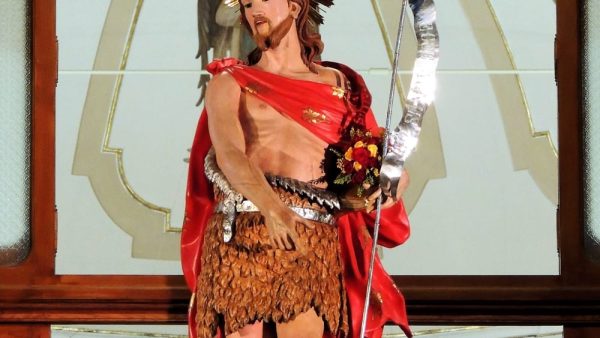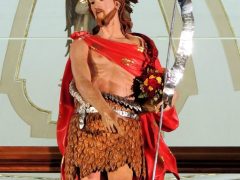Feast in honor of St. John the Baptist of Aci Castello
Description
Feast in honor of St. John the Baptist of Aci Castello
----------------
Technical sheet prepared by: Region of Sicily - Department of cultural heritage and Sicilian identity - CRicd: Regional center for inventory, cataloging and documentation and Sicilian regional film library
179
Feast in honor of St. John the Baptist
REIS - Book of Celebrations, Festivals and Ritual Practices
03-04-2014
Party / Ceremony
Catania
Acitrezza
Aci Castello
St. John the Baptist is the only saint whose birth day is celebrated on June 24th, and also that of death on August 29th. He shares this privilege with Mary the mother of Jesus because, according to tradition, both were freed from original sin in the womb.
The story of St. John the Baptist is well known by all. Descended from a priestly caste, he spent many years as a hermit in the desert, eating wild honey and locusts. On 29 AD he is found on the Jordan River to preach baptism for the forgiveness of sins. During his preaching John lashed out at King Herod, considering them sinners. His fate was precisely marked by having set himself against Herod who had him arrested and immediately afterwards beheaded.
His disciples, hearing of what had happened, took his body and buried it. His burial immediately became a place of pilgrimage and, it is said, that numerous healings took place in that place, especially of the possessed.
Many apocryphal texts, as well as Muslim books, including the Koran, speak of him; Andrew and John the apostles broke away from his disciples to follow Jesus. At first the cult of him spread throughout the known world of that time, both in the East and in the West and from Palestine innumerable churches and baptisteries dedicated to him were erected.
Such is the consideration that the Church reserves for him, that he is the only saint after Mary to be remembered in the liturgy, as well as on the day of his death (29 August), also on the day of his earthly birth (24 June); but the latter date is the most used for his veneration, by the countless churches, dioceses, cities and towns around the world, which keep him as their patron saint (just to name a few, he is the patron saint of cities like Turin, Florence, Imperia, Ragusa, etc.). This testifies to the great interest that this austere prophet has aroused in all ages, so high in the same consideration of Christ as to be defined by him as "the greatest among those born of women".
The feast of the Nativity of St. John the Baptist since the time of s. Augustine (354-430), was celebrated on June 24, for this date the criterion was used, since the birth of Jesus was fixed on December 25, that of John had to be celebrated six months earlier, according to what the archangel Gabriel announced to Mary .
The devotional, folkloristic, traditional celebrations are widespread everywhere, linked to his veneration; like so many popular proverbs they are meteorologically linked to the date of his feast.
John the Baptist is the most represented saint in art of all centuries; it cannot be said, altarpiece or picture of a group of saints, alone or around the throne of the Virgin Mary, that this saint is not present, usually dressed in an animal skin and holding a stick ending in the shape of a cross.
Not to mention the many paintings by the greatest artists such as Raphael, Leonardo, etc. depicting him as a child, playing with little Jesus, always covered with sheep skin and affectionately called "San Giovannino".
Furthermore, among the male names, but also used in female derivations (Giovanna, Gianna) it is the most widespread in the world, translated into various languages; and many other saints, blessed, venerable of the Church, originally bore her name; as indeed the almost contemporary s. John the Evangelist and apostle, because the name John, at his time was already known and in Hebrew Iehóhanan, meant: "God is propitious".
This testifies to the great devotion and popularity of this man, who condensed in himself many great identifying characters of his holiness, as a relative of Jesus, forerunner of Christ, last of the great prophets of Israel, first witness-apostle of Jesus, baptizer of Christ, hermit, preacher and puller of crowds, tutor of a Baptism for the forgiveness of sins, martyr for the defense of the Jewish law.
Annual
24 June
Celebrations in honor of the patron saint. Three days before, on June 20,21, 22 and XNUMX, the "Solemn Triduum in honor of St. John the Baptist" is celebrated
Devotional
Porters, Confraternity, Lay Associations
Children, devotees, lay associations, brotherhoods, band corps, tourists
On 24 June Acitrezza celebrates its patron saint. Throughout the celebrations, devotees tie a red triangular handkerchief with yellow edges around the neck, while the women wear a red sack tied at the waist with a yellow cord, "u vutu".
On June 23, the eucharistic celebration of the eve precedes the procession of the Holy Relic through the streets of the town. The procession begins immediately after the Vespertina Mass, opened by a long line of children of the catechism, followed by people wearing "u vutu" and carrying torches, arranged in two parallel rows, in the center of which the different flags parade of lay associations. Behind it is the Confraternity of San Giovanni Battista; to follow the band body and the population in procession.
The "Procession of the Holy Relic" runs through the main streets of the town, accompanied by prayers and songs. At the end of the procession, having reached the church square, the parish priest blesses the faithful, in a riot of joy, colors and shouts “Viva San Giovanni”, which are a prelude to the day of celebration the next day.
On 24 June the Trezzoti are awakened by thunderous cannon shots and by the notes of the band entering the town. At 10 in the morning the doors of the "cammaredda" open and St. John the Baptist, dressed up, is ready to rejoin his devotees.
Outside the church the band sings joyful notes, while in the church and outside it is all a flutter of red and yellow handkerchiefs. In the early afternoon the Traditional Pantomime "U Pisci a Mari" begins: the actors cross the streets of the town, calling the people who will follow them to the western pier where the show will take place. At 19 pm the statue of the patron saint makes his “triumphal exit”, greeted by the last rays of the sun, the cheers of the devotees and the fireworks.
The procession begins and along the way the Fercolo reaches the place where the "calata di l'angilu" takes place: an angel tied to a winch slowly descends until it reaches the statue of the Saint, bringing him the homage of the inhabitants of the neighborhood.
In the last stretch of road that separates the procession from the church, two wings of cheering crowds are ready to greet St. John the Baptist, who arrives with the traditional "a cussa" (the race), at great speed, only to be unhooked from the Fercolo and continue slowly towards the main altar.
The next morning, June 25, the Trezzoti are again awakened by cannon shots. The Saint's exit is scheduled for 19pm. Today's route covers the northern part of the town, while the day before covered the southern part. The warm evening of June resounds with the sound of bells, the din of the fires. Suddenly, in front of the church, his running slows down, he is released from the fercolo and his pace becomes slow. The doors of the "cammaredda", which welcomes the saint, are opened and slowly close, to keep it until the following year.
Buttitta Ignazio E., Palmisano Maria E. 2009. Saints at sea. Palermo: Region of Sicily
As for the relics, after being buried without his head in Sebaste in Samaria, where two churches were built in his honor; in 361-362 at the time of the emperor Julian the Apostate, his tomb was profaned by the pagans who burned the body dispersing the ashes. But in Genoa in the cathedral of San Lorenzo, those ashes are venerated, brought from the East in 1098, at the time of the Crusades.
The head of the Baptist without the jaw is kept in Rome in the church of S. Silvestro in Capite, while the cathedral of S. Lorenzo di Viterbo, would guard the Sacro Mento.
Salvatore Gambacurta
Go to Google Maps
Send a notice to the publisher
[contact-form-7 id="18385"]




